Recent Activity

Individual branches dying off under damp conditions could be a water mold (such as Phytophthora) infestation, which like many shrubs this species can get. Unless the plants were kept in quite clean situations at all times before you bought them they perfectly well could have become infested before final purchase. In my area many plant sales yards have dirty puddles and other classic sources of infestation present, including watering wands being habitually plopped onto pavement or soil between uses - instead of hung on hooks.
And if this material happened to have been grown in the South and shipped up to where you are, water molds are a huge problem in southern production operations. Because water molds love hot and wet conditions (this is why most kinds of evergreen rhododendrons cannot be kept alive in the Deep South, even when shaded and planted in raised beds).
To find out if there is a pathogen at work and which particular one it is, take samples of affected parts to your local USDA Cooperative Extension branch office, see what they can do for you. (You will have to be able to appear there during their weekday open hours).

Japanese hollies, especially the Helleri, Soft-Touch, etc, lower growers are very finicky about soil. They need excellent drainage, and a bit of shade. They are coming up all over the woods now, but I see them mostly on slopes. Could be your plants were rootbound too, and did not get watered enough initially.

Japanese holly will grow somewhat faster than boxwood does but I'd not describe any cultivar as "fast growing"! To avoid much of a need for pruning, I'd go with one of the more mounded, compact cultivars like 'Compacta', 'Green Luster', 'Hoogendorn' or 'Hetzii'.
Helleri is a great shrub but gets larger than one might imagine, especially with its spread.

My helleri shrubs are dwarfed, they have not gotten larger than 3 feet, and I have had them for several years. I researched this dwarf shrub as I wanted 3 shrubs that would remain 3 feet in width!!

Helleri can spread to 5 feet or more. I have seen some massive specimens, which have probably never seen pruners, but I assure you it will not stay limited to a 3' spread without pruning!
@chigal1, I am not familiar with that cultivar but what information I did find indicates it will also exceed a 3' width.....but not by too much. It also seems to be a bit fussier about growing conditions than other J. holly cultivars but I can't confirm that.

Deer tastes vary because the evergreen selections will expand from north to south. So that in colder zones, the selection is narrower and deer can't be finicky eaters. Blue Princess is relatively safe in Zone 7 and they never eat my Japanese holly, Inkberry, or Nellie Stevens! Cephalotaxus (plum yew) in my zone is supposed to be avoided by deer and is offered as a substitute for the true Yew (which they love), but they have at least trimmed the Plum Yew--maybe enough to realize that they don't like it--this winter it was untouched. Rhododendrons don't get touched by me, but are eaten in colder zones. I have a hedge of clumping, Fargesia bamboo (non-aggressive) that they never eat but don't think they grow in zone 5. What about boxwoods?--They hate boxwood, and Cherry Laurel, so too with Barberry--though I hate that one too! It really is trial and error though and learning about local deer tastes. Should not stop you from having a beautiful yard though. I know because I literally live in the deer crossing (an active one at that). Good luck!

I have two of the black foliaged ones, can't remember which exactly. They are in afternoon shade in a bed that gets a lot of watering. I LOVE the fragrance. Smells like grape koolaid to me.

I just found one (actually on sale)-- the Black Negligee one of the darkest forms. The dark greenish purple leaf turning darker is so stunning. I'll attempt a spot on north -facing side of the fence and companion with Pieris and Monkshood. I'm hearing these beauties take about three years to really reach maturity. Happy if well fed and mulched. Oh yes shaded.
This is honestly one the nicer looking perennial around.

I've grown Cimicifuga racemosa for a long time and love it. It likes a good moist but well drained soil and doesn't care for competition with tree roots, so that could be a problem in front of the yew. There seems to be some confusion between this plant and cultivars of Cimicufuga simplex, which include Hillside Black Beauty, Black Negligee, Brunette, Atropurpurea, Elstead, White Pearl etc. Cimicifuga racemosa is an entirely different native species, earlier blooming, green-leaved and generally more robust. The flowers have a slightly unpleasant smell but nothing to get worked up about. It's a see-thru plant, so will work anywhere in a border, including the front.

I have 'James Compton' as well and totally agree with you. Very shy flowering in my Dutch garden. I have the plant about 10 years and most years it doesn't flower. Mine is in full sun on humus rich sandy soil. I water it in dry summers to prevent the leafs becoming shrivelled. If you want flowers don't plant 'James Compton'. I prefer good old reliable 'Brunette'.

I grow actea racemosa, ramosa 'White Pearl', americana, 'Hillside Black Beauty', 'Black Negligee', 'Pink Spike' and atropurpurea. This year I am trying 'Chocoholic'.
I have a fond spot for all of them.
The black leafed varieties are truly stunning plants, though a price of $80 seems very high. Usually our nursery retails these plants for under $20 - full grown in gallon pots. I have never seen any nursery charge as much as $80 for them. They were more expensive when we first carried them, but still retailed for under $35.00
I have a soft spot for A. racemosa. It's intriguingly stinky, and smells like a combination of cat piss and b.o. But I love its flowers, it is easy to grow and blooms about midsummer. I am also very fond of 'White Pearl', which is also very easy, blooms over a long period, just after racemosa, and doesn't stink at all. It is vigourous and easy, as is the former.
The black leaved varieties are not as vigorous. They like bright, indirect light to show off their colouring, and more moisture than the others. I always count on the blossoms opening for Labour Day. The scent is heavenly and pervades the entire garden. Flower buds are pink, and bloom creamy white, which sets the foliage off nicely.
Actea pachypoda is native to the forest that surrounds our gardens, and although I grow it as an ornamental, I am not interested in the cultivar. The berries are pretty, but do not persist for long in the fall.

Even by tissue culture, propagation is a slow process; hence the higher prices. BUT you should be able to pick up gallons anywhere from $12-$20 depending on variety and nursery. Of course, dark-leaved varieties are slower growing.
General info:
The plants formerly known as Cimicifuga are typically later bloomers, get huge, and have seed pods as opposed to berries. They like some afternoon shade, but should be in a bright location with some direct morning or evening sun. They are typically woodland edge/savana plants. They don't want to be dry, but I don't find them to be water hogs once they're established either. Treat them like most plants and the'll be fine. They can tolerate full sun with extra water. I highly recommend A. 'Black Negligee' as it has been the fastest growing dark-leaved variety I've tried.
Actaea pachypoda, rubra, and a few others are the baneberries. I often see 'Misty Blue' being listed without its species name; it is a form of A. pachypoda. A. pachypoda gets white berries in summer. A rubra gets red berries, though there are white-berried populations. A. nigra is european and gets black berries. They are spring blooming woodland plants and tolerate shade very well. They all have white flowers followed by berries, either red, white, or black. All berries are poisonous. I find them growing here in maple/beech forests, which tend to be very dark. They get 2-3' tall depending on species and variety. A. pachypoda tends to be taller and more upright @ 2'-3', A. rubra is more bushy and shorter and closer to 18"-24". Best bet for success is rich soil with lots of organic matter and even moisture. Some morning sun is good for vigor, especially with A. rubra, but afternoon sun should be avoided. Currently the only one I'm aware of being vegetatively produced with any regularity is 'Misty Blue'. The rest are either seed grown (and fairly expensive- it takes up to 2 year to germinate the seed and another 5-7 years to be a salable plant) or wild collected. Wild collected material should be avoided unless you can certify it came from a construction site rescue. Plant to pay $10 or more for 4.5" quart pots for A. rubra, somewhat less for A. pachypoda as it's a bit faster growing.
Both groups are easy to grow, but require some patience.
The Plant Geek
www.confessionsofaplantgeek.com
www.botanophilia.com
www.facebook.com/botanophilia

Good drainage and crumbly, well aerated, really good woodland soil is best. Too soggy/wet in winter and spring can rot them if they aren't yet established, and soaking wet around the crowns in summer can rot them too. Better to let them wilt a little before watering, but then again, too much water makes them wilt quickly too as the roots have rotted and they can't take up moisture again. They also won't tolerate really compacted soil which may cause them to not flower.
I grow both Cimicifuga (I refuse to call them Actaea quite yet) and Actaea and they both seed about a lot. Atropurpurea is my tallest at 6 to 7 feet with amazing flowers in the fall. White Pearl flowered too late for me to enjoy before a hard freeze. The dark leaf varieties color best in bright sunlight up until noon, but also grow fine in the shade. My soil has a lot of organic matter so it drains well, and I don't water these but once or twice a week through the summer.
Chris
This post was edited by ctopher_mi on Sun, Feb 24, 13 at 17:20

Sue, the last two responses have wording typical of AI robots.
They are generic and do not offer any useful advice.

pale pinks and blues change color thru the day.. based on the intensity of the sun ...
or more precisely i should say ... your eyes perception of said color changes ...
in the olden days.. when we had real cameras.. those peeps could explain how and why ...
but a plant that looks pinkish at noon.. could easily look bluish at dusk .. depending not only on light intensity.. but on how wide open your pupil is .. and the color of the sunset ..
if you look at the pix you provided.. notice when the pic was taken ... and how the color changes ...
or better yet.. look at these pix of the pumilla ... see how they vary ... and see if you can notice when the pic was taken ...
https://duckduckgo.com/?t=ffnt&q=astilbe+pumila+chinensis&iax=images&ia=images
and finally .. part of how it all works depends on how the sun tracks thru your garden... and how your garden affects light intensity ...
imo.. just try one of each.. and find out which you prefer.. you really dont need 3 of one kind ... thats just lazy gardening ... lol ... can you tell im a collector.. not a grouper of plants ....
ken

Amethyst would bloom earlier (May- June) because it is an Astilbe x arendsii. It would form a clump.
Heart and Soul & Pumila are A. chinensis so would bloom later. The blooms of Pumila stand about 12" whereas Heart and Soul has taller flowers of about 32".
Soil must be rich and moisture retentive but A. chinensis can handle drier and sunnier sites. Not dry and sunny just more so than A. x arendsii.
Out of these I only grow Pumila . It is rhizomatous but never aggressive and blooms July though Sept.
They do appear to change colour depending on light exposure and time of day. Pinker in sun, more purple/lavender in shade.
"you really dont need 3 of one kind ... thats just lazy gardening ... lol ... can you tell im a collector.. not a grouper of plants ...."
Lol Ken! I am a collector and a grouper. Definitely not lazy!!!
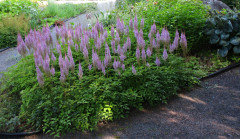
Pumila in shade
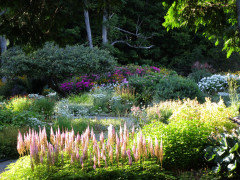
Pumila catching sun later in the day.

grouping was just marketing mumbo jumbo from landscaper who needed to get rid of all the excess stock they mistakenly bought.. lol .. and the designers they use to sell all their stuff ..
i see no downside to groping the plants you divided off your own stock plants ... thats just plain smart .. but buy more than one of any given plant.. bah ..
of course.. thats how i ended up with 1650 DIFFERENT hosta.. lol ..
ken





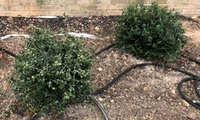
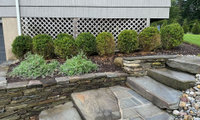
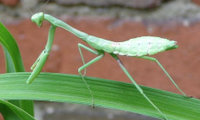
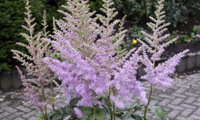
'Hoogendorn' is wider than tall, more spreading and grows somewhat slowly. In my mind it would be ideal for your usage. Eventually it can get 2 feet high x 4 feet wide -- a lot like a greener version of 'Helleri'. It rarely needs pruning. It's really a hardy and handsome shrub and I highly recommend it! I'm seeing them planted more and more around foundations here in North. VA.
That said, I think you'll be just fine with 'Compacta'. I can see why you'd not want to repurchase something when you have these already. They take shearing really well and are tough. As long as they have fair drainage, they can take clay soil just fine. BTW, Ilex crenata is naturalizing (invading?) all over our woods, so they must be adaptable to our climate!
And if a formal sheared hedge is not was was envisioned originally then the planting will not have worked out at that point.
A single story house near me has a Japanese holly above roof level, looks like it has been pruned to be walked beneath. This is not one in an historic neighborhood either. Another Japanese holly, at Lakewold Gardens near Tacoma was something like 22' high some years ago (1990s). Jacobson, Trees of Seattle - Second Edition (2006) mentions a 'Mariesii' 21 1/2' high (planted 1950), a 'Snowflake' 21' high (planted 1960), and a planting of 4 I. crenata with the tallest having reached 19'.